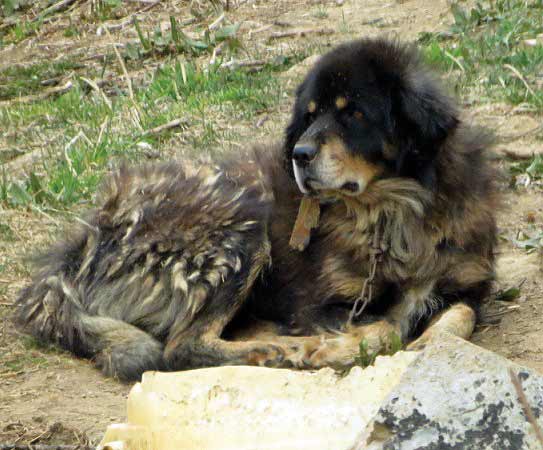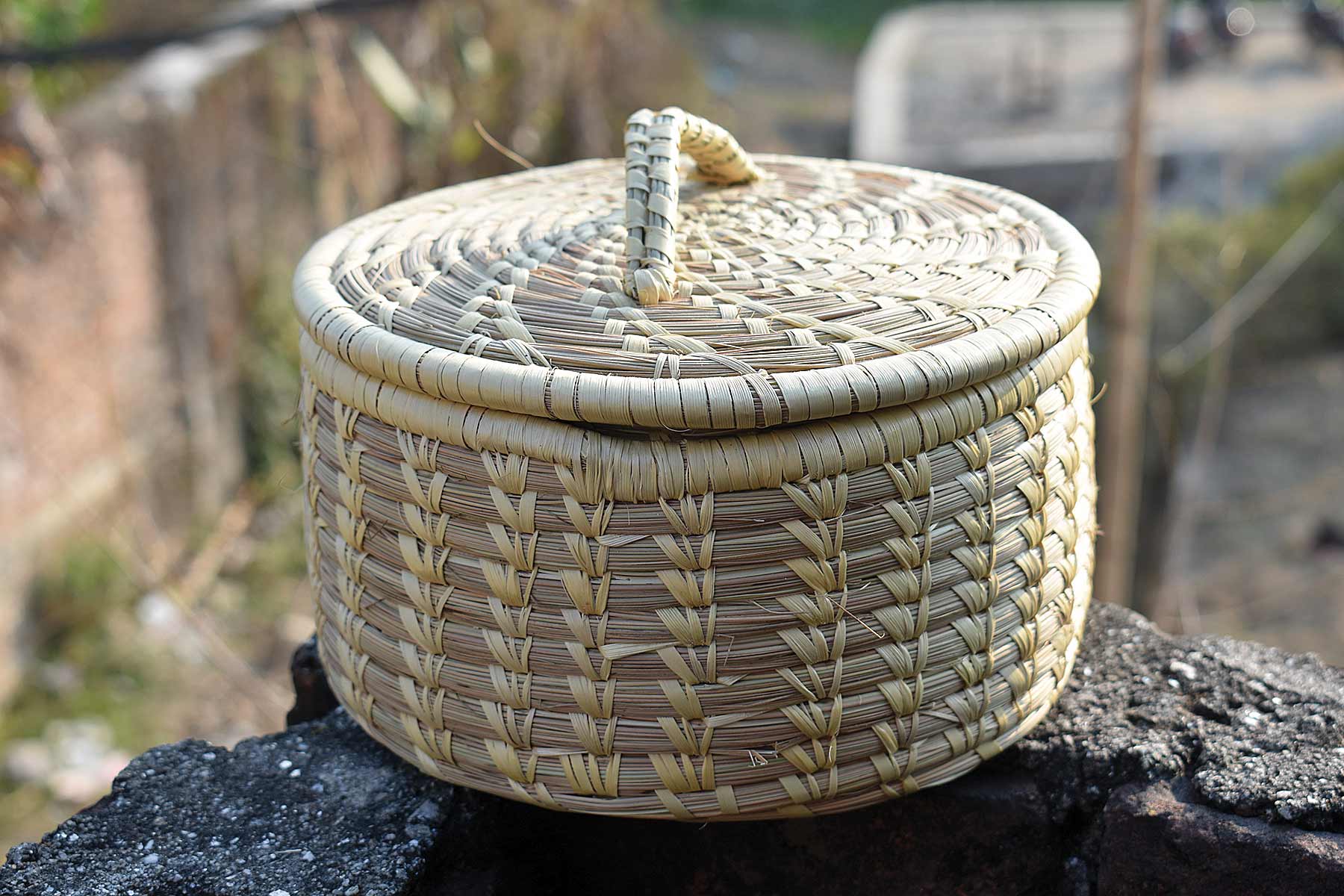After navigating the ancient salt route, crossing high passes, deep valleys, glacial rivers and meeting numerous tribes, we arrived at Hilsa where Nepal meets Tibet.
On crossing the Nepal-Tibet border on foot, we were ‘scenically’ met by a land of striking contrast. Gone were the deep gorges, the rich lush terraces, the breathtaking valleys that lay cradled beneath mighty peaks; here we entered a desolate, barren land, a land where even the gentlest of breezes felt wickedly harsh against the skin.
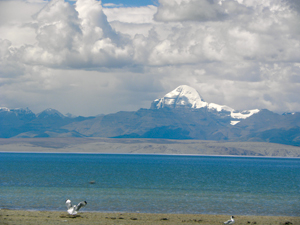
Across Manasarovar Lake's south shore rises the distant scarred face of Mt. Kailash
In the smallest of time lapses, by the act of simply crossing a border, we found ourselves thrust into another, altogether different culture. Any experience(s) encountered here was sure to be different to that which I’ve encountered anywhere else on my travels.
An officer jumped into our Land Cruiser to ‘accompany’ us to Purang. His uniform was immaculate, his skin texture like that of a baby, soft and delicate; his aura, however, emitted something quite different. His presence alone, without words, hostility or any direct contact, radiated a sense of authority, power and discipline.
Never before had I physically felt such a deep-seated sense of oppression, a sense of unease that ran through my entire body. If Ngari really was the last frontier of Tibet, then my senses were more than aware of it, my voice somehow lost to an invisible force.
Our route from Hilsa was along something that can only be described as a tarmac road. We were surrounded on all flanks by barren lands similar to those of the Mongolian steppe. In the distance, snow-capped peaks rose up from the plateau, yet here we were on a main road! Something inside me felt disturbed by that very notion. What I saw and what I felt were in absolute conflict; something about me being here just didn’t feel at all comfortable.
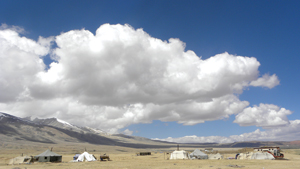
A nomad camp site on the south shore of Manasarovar
It was made clear to us that no photos were to be taken en route to Purang or in the town itself. It seems that when they built Purang, all colors and creativity had been thrown out of the window. No other color save gray dominates the town. The buildings are dull concrete blocks, the streets linear. On arrival, we were ferried into an Embassy compound where all our bags were sprayed, checked and scanned. We were asked repeatedly whether we were carrying any reading material.
Purang is considered the main trade town on the salt route and is split into different trading districts. As an outsider, to roam freely here was prohibited. So we headed along the back streets towards the Nepali sector where tiny shacks lined the alleys. Through a cloth covered doorway we entered one of the shacks. It was dark and dingy inside, the air filled with dense smoke. It took a minute for my eyes to adjust; the tiny room was filled with Nepali men, smoking, drinking Chhyang (an alcoholic beverage made from rice, millet or barley), and playing cards.
From Purang, the route took us to Manasarovar Lake (Mapam Tso) passing close to Raksas (meaning ‘demon’) Tal (tal meaning lake). These two lakes/tals, which have been recognized places of worship for millennia, form a significant part of the pilgrimage of Mount Kailash., Incidentally, Kailash is believed to be the abode of Lord Shiva by Hindus and is also revered by Buddhists, Jains and followers of the Bon faith who have their own reasons and mythologies for venerating it.
Manasarovar Lake is simple and unobtrusive. On a superficial level, it is neither exquisite nor ostentatious, but looking deeper, one soon discovers this lake’s true beauty. Home to a hidden mass of rare wildlife, Manasarovar’s unique ecosystem sustains and nurtures a variety of life forms. Pilgrims travel to the lake from great distances, and in harsh conditions, to take a dip in its waters with the strong belief that doing so rinses away their sins.
Manasarovar represents life, vitality, forgiveness, but, as with all aspects of life and humanity, to have one side is to also have its opposite. Light only exists in the presence of darkness, so it’s rather curious that Manasarovar is neighboured by Raksas Lake, the force of evil.
Raksas Tal is visually divine. Set against a backdrop of sand-colored peaks, the calm serenity of its still, turquoise waters literally captivated me. Its external beauty is exquisite, but this is merely an illusion; like a precious gemstone, it lured me, and only upon closer inspection did I realize how barren its shores were.
Nothing grows or lives here. The shore and surrounding areas are desolate. This lake represents the force of evil, a lake greatly feared by the people here, a lake representing darkness, infertility and death.
Just to clarify, the shores of Manasarovar are unobtrusive by day. After dark, though, the shores belong to the roaming wild dogs; their incessant barking was like a kind of psychological torture.
We followed the western flank of Manasarovar, heading to Tarboche at the foot of the Lha Chu Valley and the start of the Kailash Kora (circumambulatory path).
Tarboche is adorned with hundreds, if not thousands, of colorful prayer flags. From the flat plateau we suddenly stood at what looked like a gateway into another world. Here, besieged by vertical walls of a deep black rock, we stood shrouded in a veil of shadow.
As we walked the valley, we were awarded a fleeting glimpse of the western face of Mount Kailash.
We pitched directly under the mountain’s north face from where the view was divine. Kailash rose up like a geological dome, its sides harsh and severe yet its summit beautifully curved. It was a long trudge up to the Drolma La pass (5,630 m). The weather stayed overcast and there was slight and occasional snowfall. The ascent was emotionally charged – at times I looked on with disbelief at other people incapable of physical exertion, and plodding up the same trail as I was, somehow discovering, through their faith, an inner will and determination to succeed.
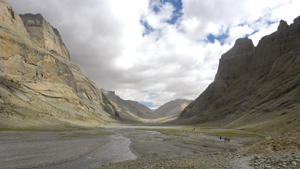
The Lha Chu Valley
The pass was covered with hundreds upon hundreds of multi-colored prayer flags, the rocks dressed with different items of clothing. To sacrifice clothes here means that those very clothes will be available during the transition period after death. The atmospheric energy at the Drolma La was a complete paradox, a sensual mix of intensity, caused by the physicality and serenity resulting from euphoric states of consciousness.
After crossing the pass, we descended past the Thukpe Dzingbu (Lake of Compassion) where an intense emotion enveloped me. From behind my sunglasses ran a thousand tears as I watched small Tibetan children gently guide and support elderly members of the Hindu, Buddhist and Bon communities over high altitudes and challenging terrain.

Raksas Tal, which represents the force of evil, is visually appealing
At times I found it difficult to restrain myself as infirm pilgrims took out their frustrations on those guiding them. The atmosphere was intense. My emotions ran from anger to a peaceful and complete sense of acceptance; I was amazed at the humility and patience shown by these people – for me it is they who are the true inspiration out here.
After experiencing the Tibetan full moon and a night of severe wind buffeting, we awoke to complete and utter stillness. The skies had cleared to reveal the expansive valley and our route ahead. We were now on the final leg of the pilgrimage, circumambulating the eastern face. Here the valley mouth was open, displaying a riot of grass and wild flowers. The etched hillsides appeared vibrant and fresh. Once again the gentle birdsongs had returned to fill the air.
On completing the Kailash Kora, our bodies were filled with a sense of stillness. To a land that is often inhospitable and oppressive, we found ourselves forever drawn. With palms pressed together, we bid farewell to our yaks, and without glancing back, strode back into the great world beyond.
Emma Finney is the UK Representative for Responsible Treks, a Kathmandu-based travel company. Emma is an avid traveller with a keen passion for wilderness landscapes, the mountains and the therapeutic benefits such places can bring. She can be contacted at finlay80@hotmail.co.uk; Website details: www.persoots.com


